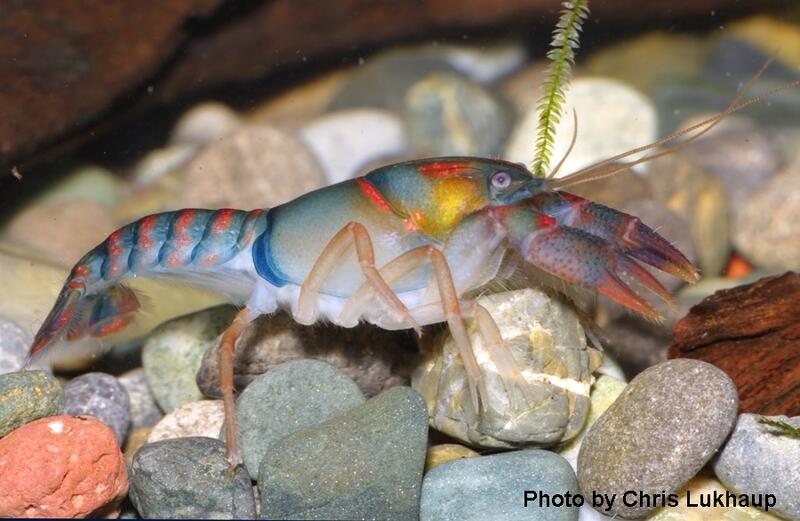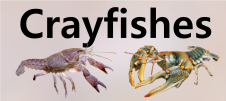







Loading profile. Please wait . . .
Procambarus pygmaeus Hobbs, 1942
Christmas Tree Crayfish




Federal Protection: No US federal protection
State Protection: No Georgia state protection
Global Rank: G4
State Rank: S3
Element Locations Tracked in Biotics: No
SWAP 2015 Species of Greatest Conservation Need (SGCN): No
SWAP 2025 Species of Greatest Conservation Need (SGCN): No
2025 SGCN Priority Tier: None
Element Occurrences (EOs) in Georgia: 0
Habitat Summary for element in Georgia: Georgia habitat information not available
The overall color of the Christmas Tree Crayfish is dark greenish-olive with red highlights. The red coloration is found on the carapace, joints of legs, and as transverse bands on the abdominal segments. The claws are lighter green than the body and have darker green or gray tubercles; the ends of the fingers may fade to a light brown. The mesial margin of the palm has a single row of jagged tubercles. The areola is very narrow. The rostrum tapers and there are no marginal spines or tubercles. This species reaches a maximum total body length of about 54 mm (2.1 in).
Across its range, no other species has the green and red coloration of this species. The color apparently fades rapidly after capture (Hobbs 1981) and without it, the Christmas Tree Crayfish looks very similar to all of the other species previously assigned to the subgenus Hagenides in Georgia. Since its range overlaps with all four of the other Georgia Hagenides, any species of this subgenus should be examined carefully.
The Christmas Tree Crayfish can be found among vegetation in flowing streams or in burrows adjacent to streams or ditches or other soggy areas.
No studies of the Christmas Tree Crayfish are known. Crayfishes are considered opportunistic omnivores and likely feed on live and decaying vegetation, aquatic insect larvae, small fishes, and dead animal matter.
Christmas Tree Crayfish is found in both open water and fairly complex burrows. Reproduction likely occurs during the spring and fall, but males in reproductive condition may be found at any time during the year. When female crayfish are ready to lay eggs, they usually find a secure hiding place and hence are rarely encountered. In the case of secondary burrowers, females probably use burrows when they release their eggs. After the eggs are released, the female attaches them to her swimmerets and is said to be “in berry.” Upon hatching, the juvenile crayfish are attached to the mother by a thread. After the juveniles molt for the second time, they are free of the mother, but stay close and will hold on to her for some time. Eventually they move off on their own. Crayfishes molt 6 or 7 times during their first year of life and most are probably able to reproduce by the end of that year. They molt once or twice a year for the remainder of their lives and live about 3 years. Male Christmas Tree Crayfish in reproductive condition have been collected in March, April, May, June, October, November, and December. Females with eggs have been found in March and July in Georgia, and May in Florida (Hobbs 1981). The smallest breeding male known is about 33 mm (1.3 in) and the smallest female with eggs about 42 mm (1.7 in) in length (Hobbs 1981).
Kicking into a seine through vegetation along the edges of creeks may reveal this species. Since it inhabits burrows as well, excavating burrows along waterways or in other wet areas may produce this species as well.
The Christmas Tree Crayfish is distributed from the eastern panhandle of Florida, eastward across the northern one-third of the state and northward into southern Georgia. In Georgia it is widely distributed in the southeastern portion of the state from the Alapaha River to Savannah River system (Hobbs 1981).
This species is threatened in Georgia by land uses within its range that could alter hydrology and water quality. Introduction of non-native species is a threat to all native crayfishes.
This species is common and widespread in Georgia and is thus considered secure.
General watershed level protection measures will help secure the continued existence of the Christmas Tree Crayfish in Georgia. These include the protection of riparian zones, control of sediment and nutrient runoff from farms and construction sites, and limiting the amount of impervious cover (e.g., pavement) within occupied watersheds. Non-native crayfishes should never be used for bait. Instead, anglers should use crayfishes collected from the river system they will be fishing in and should never release unused bait crayfish back into Georgia waters.
Hobbs, H.H., Jr. 1981. The crayfishes of Georgia. Smithsonian Contributions to Zoology 318:1–549.
Taylor, C.A., G.A. Schuster, J.E. Cooper, R.J. DiStefano, A.G. Eversole, P. Hamr, H.H. Hobbs III, H.W. Robison, C.E. Skelton, and R.F. Thoma. 2007. A reassessment of the conservation status of crayfishes of the United States and Canada after 10+ years of increased awareness. Fisheries 32:372–389.
Christopher E. Skelton
C. Skelton, October 2012: original account
C. Skelton, March 2019: general update of account.
D.Weiler, Septemeber 2019: photo added